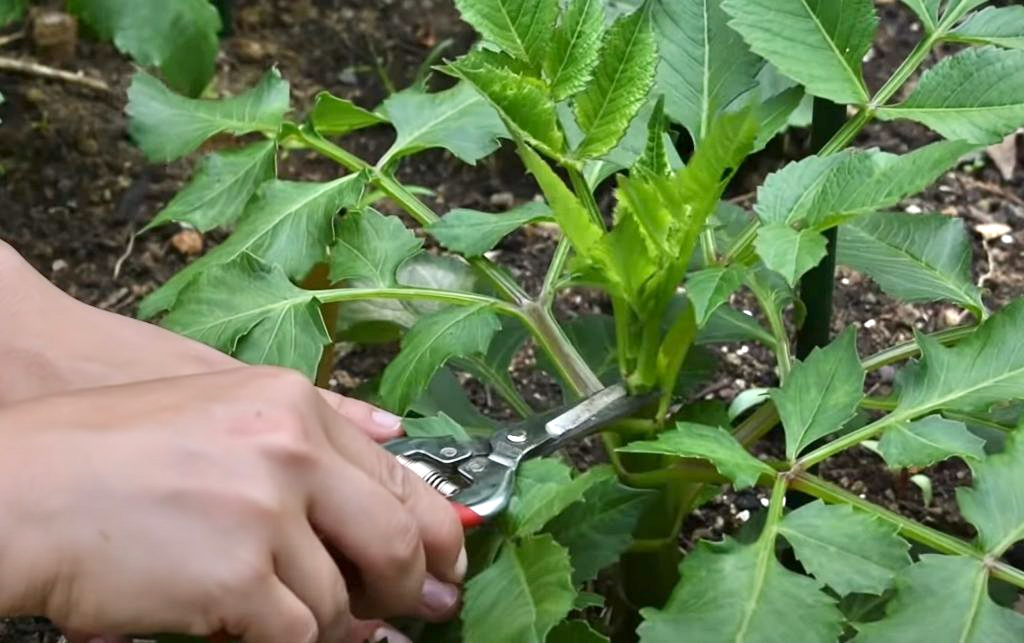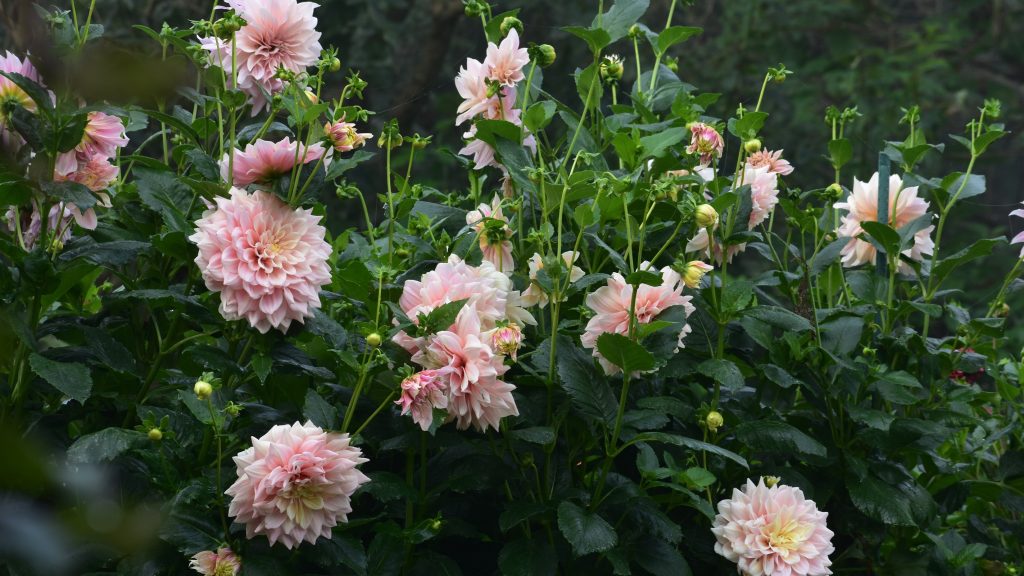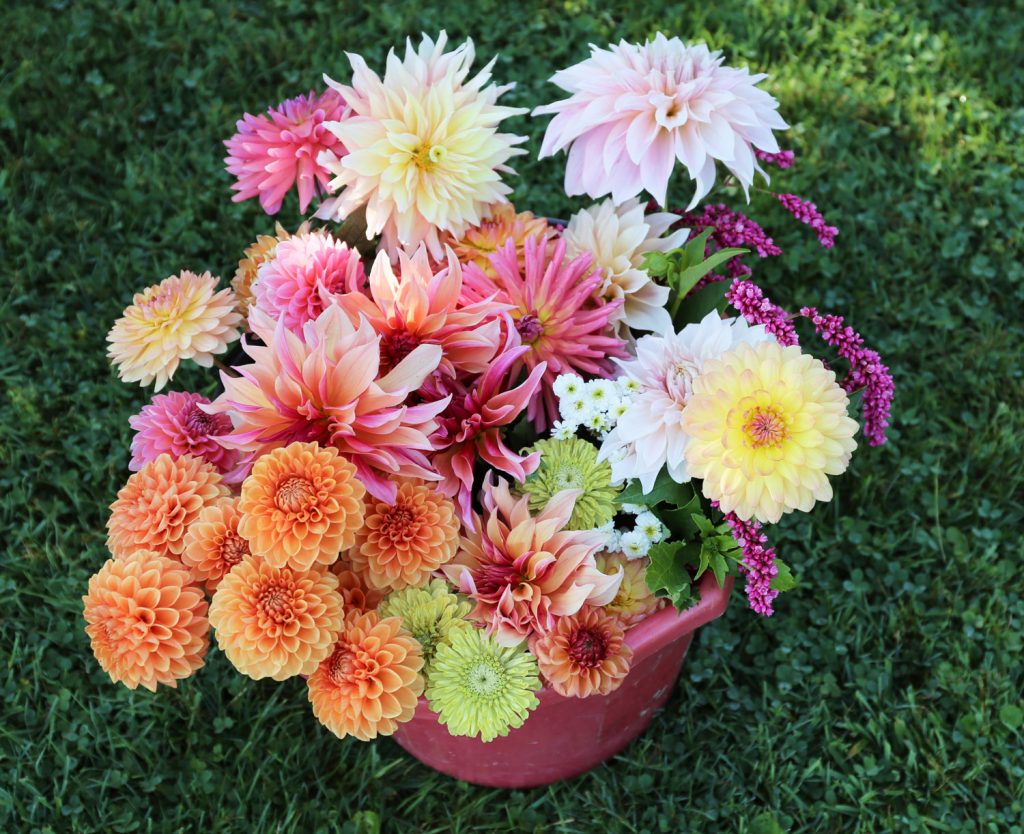How to Get Your Dahlias to Produce More Flowers
Dahlias are workhorse plants that pump out tons of blooms from midsummer until frost. Though they naturally put on a fabulous floral show with little human intervention, with a few additional steps, you can maximize dahlia production and get long, strong stems of pristine dahlia flowers all season long.

Pinch and Propagate
At the start of the season, when your dahlia plant is 8-10 inches tall with at least four sets of true leaves, pinch out the top directly above a set of leaves. This technique is sometimes called topping and it encourages the plant to create an abundance of long side branches.
Thinking of composting those cuttings? Think again! With some rooting hormone and a tray of potting mix, you can root the cuttings and make more plants. Prepare a cell tray with moistened potting soil and make a deep hole in each cell with a pencil. Creating this hole ensures that the rooting hormone stays on the cutting and also keeps it from breaking. Place a small amount of rooting hormone on a disposable dish. Now you're ready to pinch your dahlias and take cuttings at the same time.
In the early morning, cut out the central stem above four sets of leaves. Remove all but the top set of leaves from the cutting and make a fresh cut right below a node (see photos below). Dip this cutting into the rooting hormone and then stick it immediately into the moist potting soil that you’ve prepared. Snug the soil around the cutting to secure it in place.

Now treat the cuttings just as you would any other baby seedlings. Put them under grow lights or in a greenhouse and keep the soil evenly moist at all times. Don’t worry if the cuttings look sad for a few days. This is normal. Misting the cuttings daily will help keep them hydrated. One morning you will wake up and they will have perked up. After 6 weeks or so they will be ready to transplant into the garden.

Staking
Any dahlias that will grow to be more than 36 inches tall should be staked. Otherwise, the plants can fall over and the stems can crack from the weight of the flowers or a summer storm. Stake your dahlias at planting time and continue to tie them in every 12-18 inches or so throughout the growing season.

Proper Watering
Newly planted dahlia tubers should not be watered until they sprout. Once they are actively growing and approximately 24 inches tall, it's time to begin a regular watering schedule. Soil and weather conditions vary greatly from one location to another, but your goal is to give the roots, which are approximately 8 inches below the soil surface, 1-2 inches of water per week. Deep watering 2-3 times per week is much more effective than shallow daily watering.

The Importance of Fertilizer
Dahlias are hungry plants and benefit from being fertilized. How much and how often to fertilize, depends on the fertility of your soil. If possible, test your soil (through your local extension service or a soil lab) before the start of the growing season.
Dahlias need a full range of plant nutrients, but generally speaking, they should get more nitrogen in their youth, and less nitrogen as they mature. Start fertilizing once the plants are 24 inches tall. Fish emulsion is an excellent early season fertilizer that can be applied once or twice a month, depending on the dilution rate and the fertility of your soil. Midseason, switch to a low-nitrogen fertilizer and continue feeding once per month. A weekly foliar feed of comfrey or compost tea is also beneficial for plant health.

Cutting Stems to Maximize Blooms
Dahlias should be cut in the early morning or late evening when the flowers are well hydrated. Unlike most other types of flowers, dahlias buds will not open in a vase. Wait to cut the blossoms until they are almost fully open. The back of the flower head should be stiff, and the back petals should stay in place when you rub them.
When harvesting, make deep cuts so you get stems that are 18-24 inches long. To get stems this long, you need to sacrifice side buds. This is hard to do, but it's the correct way to harvest and will pay off with a consistent supply of long stems.

Conditioning the Flowers
There are a few schools of thought on how to condition dahlias for the longest vase life. Some gardeners sear the cut stems in hot water, while others do not. Consider trying one of the following searing techniques and see what works best for your needs.
Post-Harvest Conditioning Method One: Immediately after harvest, place the stems into 2-3" of very warm water that is between 160-180°F. If possible, add flower food into the bucket. For best results, use a large plastic bucket and do not crowd the flowers as steam can damage their delicate petals. After one hour of conditioning in the bucket, remove the stems and put them into fresh, clean water.
Post-Harvest Conditioning Method Two: After harvest, dip the stems into boiling water for 7-10 seconds taking care to keep the bloom heads away from the steam. You will see the stem end change color during this time. Next, place the stems in a bucket of cool water and allow them to rest for a few hours before arranging. If you’re selling dahlias, you can hold them in a cooler at 40°F.
It’s important to note that most dahlias, even when conditioned properly, will only have a vase life of 3-5 days. There are also big variations in vase life depending on the flower type and variety. Ball dahlias tend to have the longest vase life and fluffy dinnerplate dahlias the shortest.

Deadheading is a Must
Dahlias need to be deadheaded regularly so the plants can continue to send their energy into flower production. Take time to remove the entire stem right back to a main stalk. This encourages the plant to produce longer stems and also promotes good air circulation within and around the plant.
The best time to deadhead is when you are cutting flowers. Bring a bucket with water for the stems you want to bring indoors. Bring a second one to collect any blossoms that have passed their prime. Cut the spent blooms just as you would a perfect blossom. Take enough of the stem to encourage more branching.
Once a dahlia has dropped its petals, it becomes difficult to tell the difference between a bud and a spent bloom. If you look closely, you'll see that spent blooms come to a point while buds are round.

Use Organza Bags for Pristine Blossoms
Munching critters such as earwigs and Japanese beetles love to feast on dahlia blooms. Thrips can also cause damage. Luckily, there's a safe and effective way to have perfect blooms without the use of pesticides.
The solution is organza bags. Once your dahlia has formed a large bud, and before the petals have opened, enclose it in an organza bag. Use a 12x16 or 8x8 bag depending on the flower size. Pull the strings closed taking care not the crush the stem. Allow the dahlia to open inside the bag. Viola! Perfect blooms every time!

Start With High-Performing Varieties
Some dahlia varieties are more productive than others. Generally, the bigger the blooms, the fewer you'll get. So you can expect dinnerplate dahlia Cafe au Lait to produce fewer flowers than single dahlia H.S. Date. If your goal is to get the maximum number of flowers, look to high volume producers such as Cornel, Blizzard, American Dawn, Maarn, Ivanetti and Cornel Bronze.
You can shop our selection of more than 100 dahlias HERE. To learn more about growing dahlias, you may be interested in reading:
